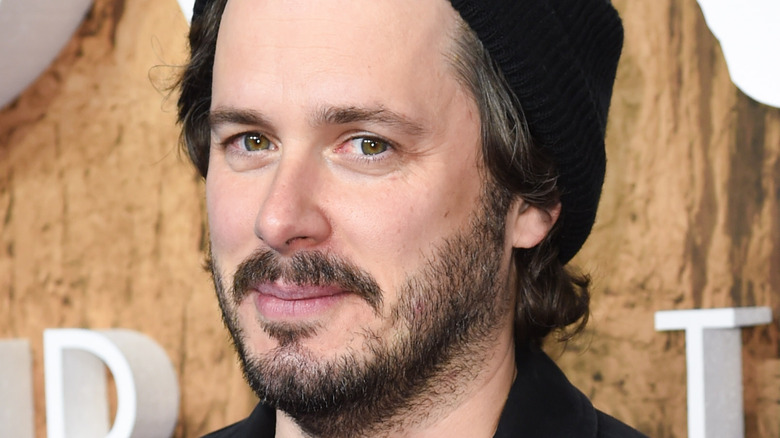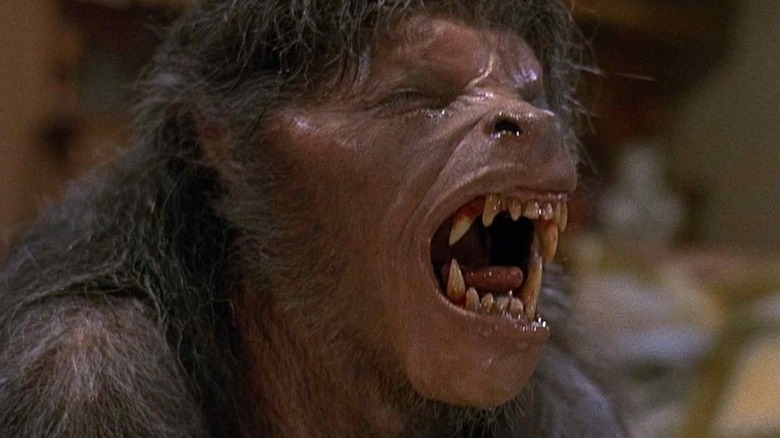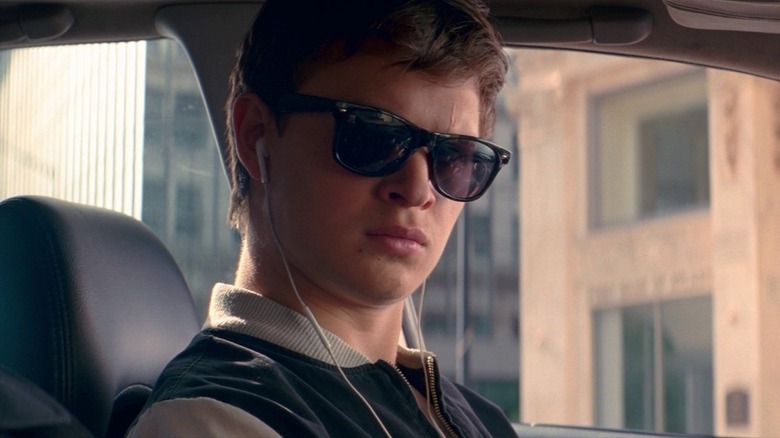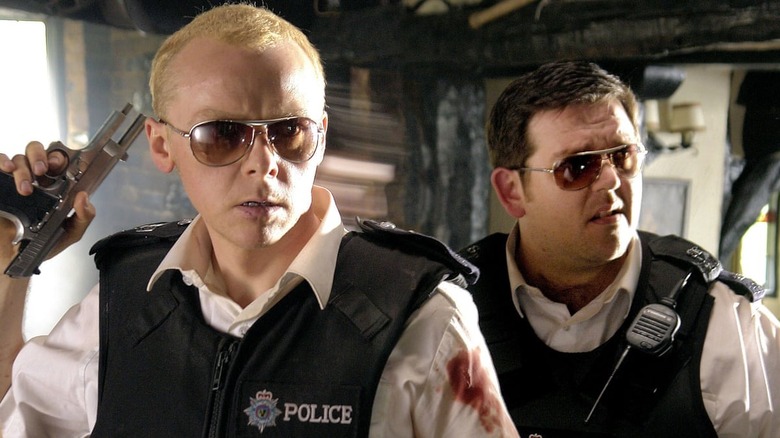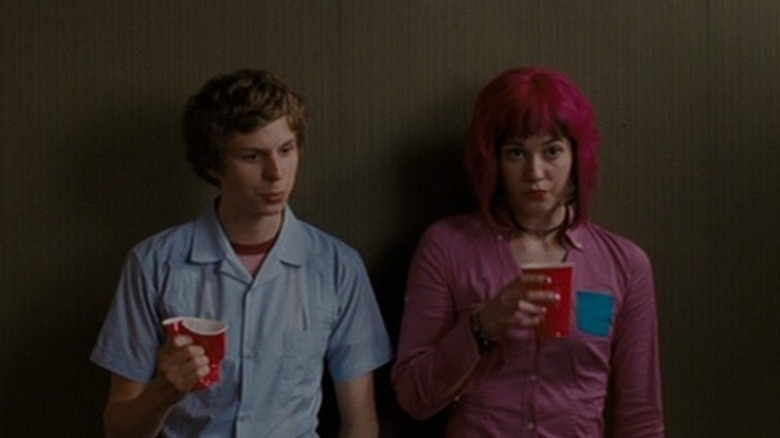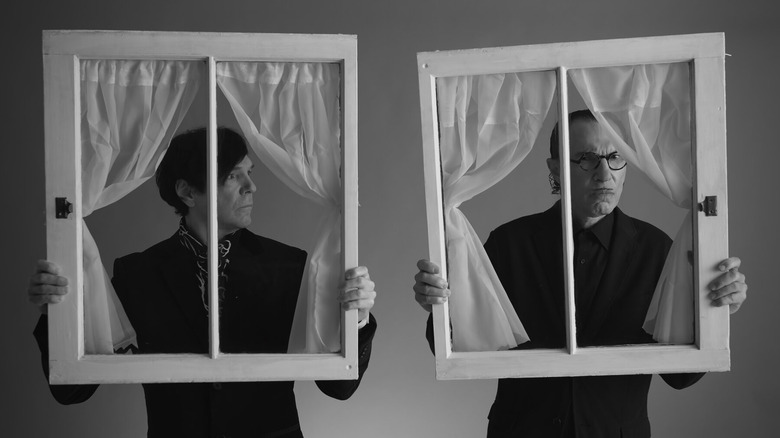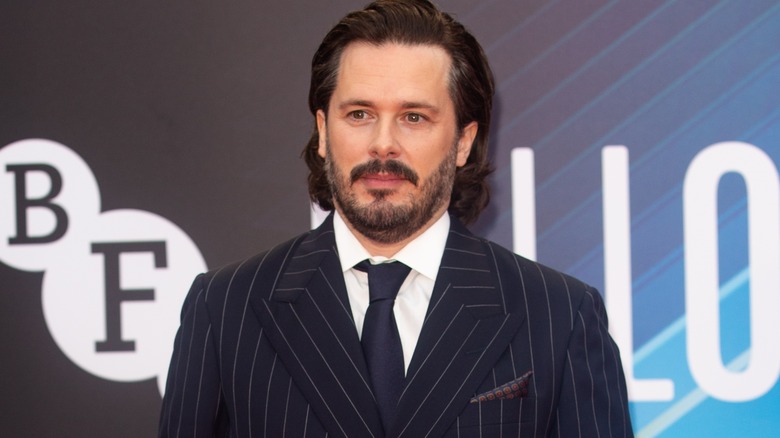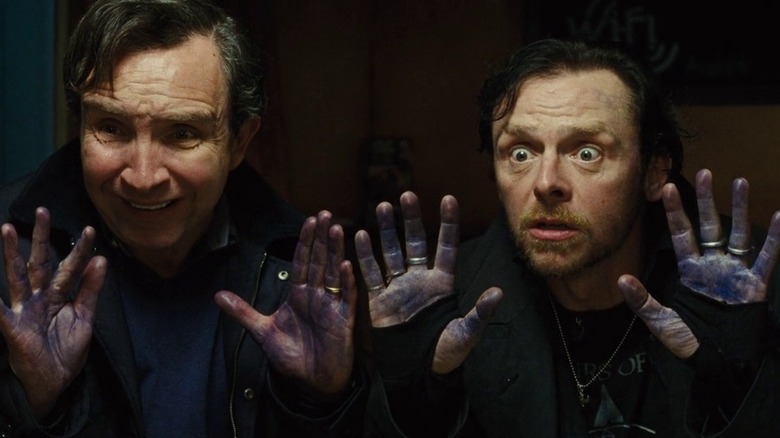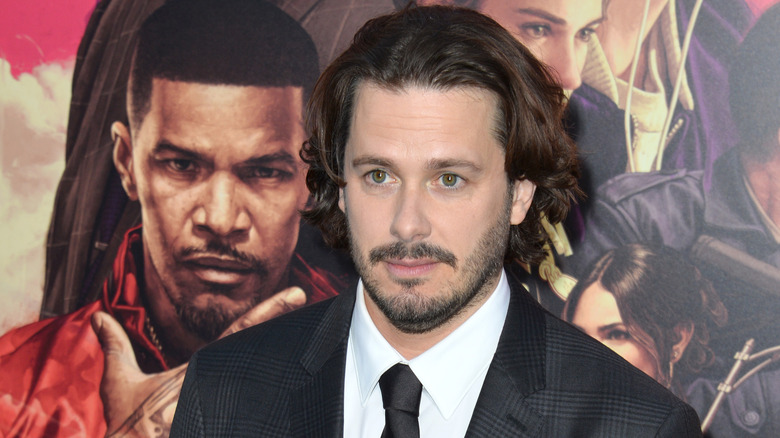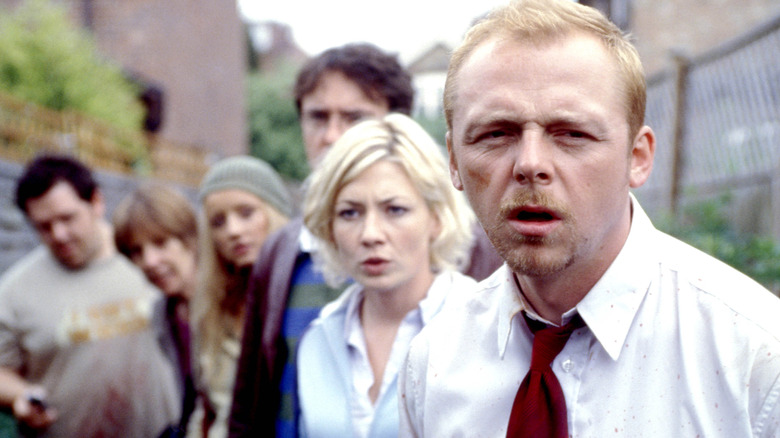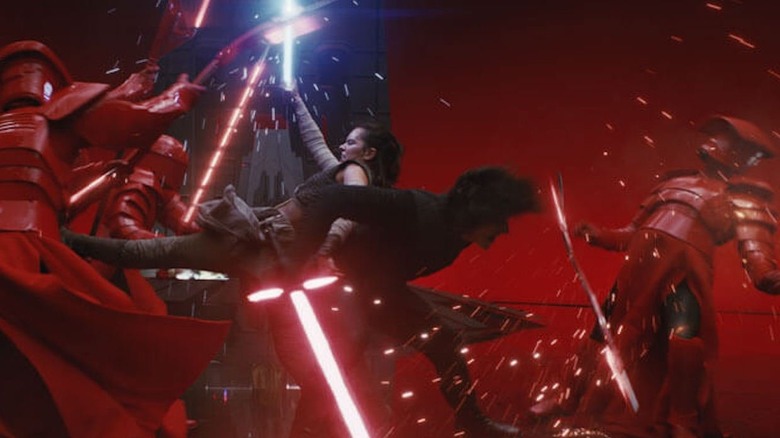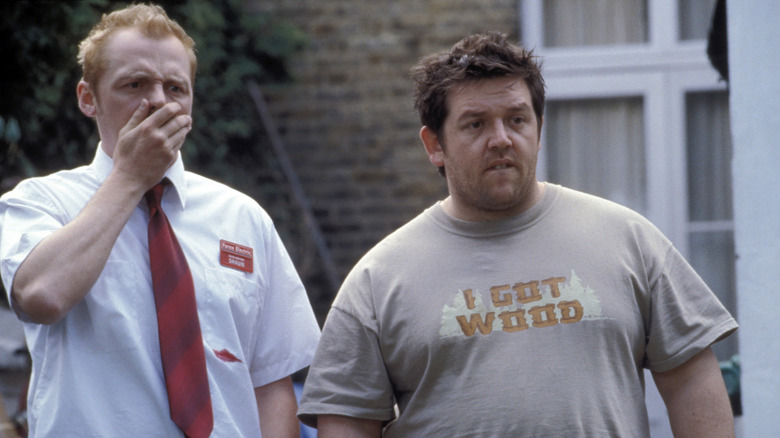The Untold Truth Of Edgar Wright
Dating back to his time working on the TV show "Spaced," Edgar Wright has been an uncompromising artist who embraces what others may see as too unusual or too mold-breaking. His works are entertaining comedies or action films, but they're also exquisitely designed productions reflecting bold creative choices that ensure they'll never be mixed up with other features in the genres they inhabit. These largely unpredictable motion pictures keep you on your toes, but you can always count on an Edgar Wright movie to subvert expectations and deliver something you never knew you needed in your cinematic diet.
While these aspects of Wright's work as a filmmaker are well-known, that doesn't mean everything about this director is common knowledge. The untold truth of Edgar Wright is full of things even devotees to his projects may be unaware of, including the 1980s horror film that left a massive impression on him, as well as how long he spent stewing over the screenplay for "Baby Driver." Taking the time to fully consider everything revealed about him just further reaffirms how Wright is one filmmaker you can't get out of your brain — especially once his movies have found their way in there.
An American Werewolf in London was an influential film for Wright
The filmography of Edgar Wright is already so eclectic and unique that it's hard to pinpoint a single film that could have inspired his filmmaking career. From the frantic pop culture melting pot that is "Scott Pilgrim vs. the World" to the creative crime thriller "Baby Driver" to the individual installments of his Cornetto Trilogy, it would be difficult to figure out what single motion picture inspired the artist behind such a wide range of movies. Per Wright himself, an equally unorthodox project served as the movie that lit a fiery passion for filmmaking.
In a 2010 essay for The Guardian, Wright divulged that the John Landis feature "An American Werewolf in London" was one of the most influential movies he's ever seen. Wright was especially enamored with how many different things this one film managed to accomplish: It was scary, for sure, and full of werewolf carnage, but it also contained laughs and moments that got you invested in the characters. Combining that quality with other distinctive features like idiosyncratic jokes proved enormously impactful on Wright. Though he hasn't made a movie about werewolves yet, Wright has made films that juggle multiple tones and genres in a way that would make the creators of "An American Werewolf in London" proud.
Wright spent 22 years conceiving Baby Driver
Edgar Wright's 2017 feature "Baby Driver" is an extremely precise creation, particularly in its editing and its song choices. Every aspect of the film reflects the long and careful planning that Wright must have put into it. It turns out, though, that Wright spent even longer than you may suspect on "Baby Driver." He spent a whopping 22 years working on this idea before the title ever reached movie theater screens.
Speaking to The Guardian, Wright revealed that he'd first had the germ of an idea for a car chase movie like "Baby Driver" in the 1990s. In fact, a music video he directed for the band Mint Royale utilized his conception of the opening scene in an early draft of the "Baby Driver" script. In the time it took to get from his brain to the silver screen, Wright noted that other films had come out, like "Drive" and "Guardians of the Galaxy," that people assumed he'd taken inspiration from. Clearly, though, Wright got there long before any of those films, with his commitment and dedication to the project resulting in the lovingly-detailed nature of "Baby Driver."
What informed the energetic filmmaking of Hot Fuzz
Watching "Hot Fuzz," you can be forgiven for feeling practically winded once the film reaches its hysterical conclusion. The whole feature is just so packed with gags, all arriving at whirlwind speed, that it can take multiple viewings to truly appreciate the finer details in individual jokes. Some comedies aim for a more laidback style to better allow for improvisational comedy, but comedies from Edgar Wright like "Hot Fuzz" opt instead for a breakneck speed that's truly idiosyncratic and impressive to watch.
Speaking to Collider, Wright revealed that the incorporation of this speedy style of comedy filmmaking into "Hot Fuzz" was intentionally meant to evoke the style of then-modern action films from directors like Tony Scott, such as the Denzel Washington vehicle "Man on Fire." While some critics and filmmakers had seen these hyper-edited blockbusters as shallow works of empty spectacle, Wright was genuinely impressed with them and saw their value as pieces of cinema worth emulating. He also felt that going this route on this specific story added an extra layer of comedy to the proceedings. Mundane aspects of Nicholas Angel's police work, like filling out paperwork or sliding a cup of tea across the table, could be executed through camerawork and editing usually reserved for a car chase in a Michael Bay film. With "Hot Fuzz," Edgar Wright found plenty of thoughtful reasons to put the pedal to the metal and deliver an energetic spirit you just can't resist.
How did Wright get Cate Blanchett to show up in Hot Fuzz?
Early on in "Hot Fuzz," protagonist Nicholas Angel (Simon Pegg) has a brief chat with his ex-girlfriend, who's covered in a full-body hazmat suit. It's an amusing sight gag, but also one that concealed an impressive cameo. Underneath that suit was none other than modern silver screen legend Cate Blanchett. She doesn't get to appear in "Hot Fuzz" beyond this scene nor does she get to step out of that concealing outfit, but it's still remarkable that Blanchett would show up in a feature this overtly goofy.
Edgar Wright explained to Collider that he managed to snag Blanchett for the tiny role after he ran into her in Los Angeles and discovered she was a fan of his 2004 film "Shaun of the Dead." Additionally, her presence served as a personal reference for Wright to how many times financiers of "Hot Fuzz" pressured him to pack more big-name actors into the cast. To play off these unyielding requests, Wright made the cheeky decision to sneak a big-name dramatic performer into "Hot Fuzz" — but audiences would never actually get to see her.
Wright's biggest hurdle in making Scott Pilgrim vs. the World
When you're watching "Scott Pilgrim vs. the World," the visual effects, the performances, and the editing all look so effortless. But of course, it took hours upon hours of detailed craftsmanship to bring such an idiosyncratic piece of filmmaking to life. All those finer nuances meant that there was no shortage of challenges that director Edgar Wright and company faced in bringing this movie to life. However, for Wright, there was one particular challenge that proved more meddling than anything else.
For Wright, the biggest hurdle, per an interview with Complex, was in "getting the level of reality right" since the movie floats between grounded conversations and stylized battles drawing on imagery from video games and movies. "I thought it would be really interesting to try and pull off in live action," Wright explained. "Because most comic books are striving to be really realistic ... What was fun about this was creating this magical realism and insanity out of this mundane, everyday world." In taking this approach to a comic book adaptation, Wright put in a lot of work, but given the critical and long-term success of "Scott Pilgrim vs. the World," it's clear all that effort paid off handsomely.
Edgar Wright's experiences working with Sparks
Having already made action-comedies like "Hot Fuzz" and a heist/chase film like "Baby Driver," it would seem like Edgar Wright's already stretched himself mightily as an artist. But this filmmaker continued to expand his horizons with his 2021 feature "The Sparks Brothers," which served as Wright's first foray into the world of documentary filmmaking. This project saw Wright chronicling the obscure rock band Sparks. They may not be household names, but this was a musical group that Wright had been enamored with for years and that had left a sizable impact on the world of music.
Wright revealed to Polygon that he spent nine hours recording new footage of the founding members of Sparks, Ron and Russell Mael, and that they proved fascinating figures to interview. "They're very funny, they're really accomplished," Wright explained. "They really do believe in the art of writing pop songs ... and then just how much effort they put into the visuals, and the fact that they can laugh at themselves, that all made them the perfect interviewees, as well as the perfect subject matter." Such "perfect subject matter" makes it easy to see why Wright would feel comfortable using Sparks as a launchpad to dive into documentary filmmaking
Wright's attitude about nostalgia
A yearning for the past informs the crux of Edgar Wright's finale to The Cornetto Trilogy, the 2013 film "The World's End." Protagonist Gary King (Simon Pegg) is defined by clinging to the glory days when he and his younger friends attempted to do an expansive pub crawl, an obsession that, combined with his own struggles with addiction, is ruining his life. This exploration of the damaging side effects of becoming defined by the past is emblematic of Wright's own attitudes towards nostalgia as a concept.
"I think it's okay to get nostalgic over music or movies from your youth, but this film is about the dangers of trying to recreate former glories," Wright explained to IndieWire. "You can't rest on your laurels and you can't relive your teenage years forever; it's ridiculous." Embracing that attitude ensured that the approach to nostalgia in "The World's End" would end up being as affecting as it was.
Which movies inspired The World's End
For "The World's End," Edgar Wright was going to have to pull out all the stops. Not only was this his first foray into explicitly science fiction material, but it was also the conclusion to his deeply personal Cornetto Trilogy. To pull this feature off, Wright burrowed deep into his passion for all things cinema and leaned on a variety of prolific titles to help fuel his creative passion for "The World's End."
Wright, while noting this project was more personally-driven than some of his other works, openly admitted to Indiewire that works like "The Fog" inspired "The World's End," as did "movies about small-town paranoia" like "Invaders from Mars." The original "Westworld" film, meanwhile, helped influence some of the visual effects techniques pulled off in "The World's End." Beyond cinema, Wright was also looking to literary greats like John Wyndham and Nigel Kneale as further inspiration. With this wide variety of creative motivators set, Wright proceeded to embark on crafting the distinct piece of cinema that is "The World's End."
Wright's attitude on making a musical
Music has frequently played an important role in the works of Edgar Wright. Just look at how the titular lead of "Scott Pilgrim vs. the World" is in a rock band called Sex Bob-omb or the fact that Wright focused on an obscure rock group for his first documentary, "The Sparks Brothers." Given his ongoing fascination with music, it's a little surprising none of his directorial efforts, to date, have managed to include a musical. However, Wright apparently is down with the idea, provided he can crack a proper story.
After commenting about how Alfonso Cuaron asked Wright when he was going to get around to the musical genre after a screening of "Last Night in Soho," Wright told Den of Geek that he'd make a musical "if I found the right subject matter or something that I felt could be a really great movie that I could make, then yeah, for sure." While nothing's officially on the docket yet, it certainly seems like Wright is more than up for tackling a big-budget musical. If such a project were even half as visually dynamic as prior Wright films like "Scott Pilgrim vs. the World," it could be one for the ages.
His insistence on practical effects in Shaun of the Dead
If you're making a 21st-century horror movie, you have a slew of tools in the form of computer effects at your disposal that previous generations of horror filmmakers could have never even imagined. However, relying on these too heavily can end up injecting an inescapable sense of inauthenticity into your movie that can sink any chances of your project actually scaring people. Recognizing this, Edgar Wright was insistent on practical effects being the norm when helming his 2004 film "Shaun of the Dead."
"My intention was not to use any at all, you know," Wright said to Drafthouse about deploying CGI in "Shaun of the Dead." "I'm sort of an old school snob when it comes to that sort of gore thing — I didn't want people to be acting at nothing, reacting to where I said a monster was." Wright did note that he didn't entirely dismiss more modern approaches to visual effects on the feature. While directing "Shaun of the Dead," the technicians on the project showed him how CGI could be used delicately to enhance the impact of on-set practical effects. This provided an opportunity for modern digital techniques to enhance, rather than replace, classical approaches to executing zombie carnage. It was a delicate balance that ensured old-school visual effects still had a prominent role on "Shaun of the Dead."
Edgar Wright had a cameo in Star Wars: The Last Jedi
Save for coming close to directing the Marvel Studios project "Ant-Man," Edgar Wright has largely stayed away from directing franchise fare. But Wright hasn't entirely avoided being associated with such projects. In 2017, Wright became connected with the immortal "Star Wars" saga by appearing in a minor capacity in Rian Johnson's "Star Wars: The Last Jedi."
Why did Wright end up in this particular "Star Wars" movie? In addition to being a fan of the franchise, Wright was friends with Johnson, who invited his fellow filmmaker to the set. As Wright explained to The Guardian, he, his brother — comic book artist Oscar Wright — and "Attack the Block" director Joe Cornish showed up in one scene as resistance fighters. "I play rebel scum with a gun," Edgar said. "You'd have to look hard for me but I'm in a three-second shot. I was very proud of Rian. He did a great job."
On Shaun of the Dead translating to American audiences
Edgar Wright's "Shaun of the Dead" is an unabashedly British film, with nary a major American character in the cast to provide an audience surrogate for viewers from that country. This comes from the fact that Wright never had any concerns over whether or not people from outside the UK would find this zombie comedy amusing.
"There are small things, you know, that we knew wouldn't make a lot of sense," Wright said to Drafthouse about his initial concerns over whether "Shaun of the Dead" could play outside of Britain. "But you get it in context I think ... this whole idea that humor doesn't translate, that's something that's disproved again and again, isn't it." In Wright's eyes, studio executives have an inaccurate perception that American moviegoers won't tolerate media made outside their borders. The director further observed how there have been repeated instances disproving the idea that people from one country couldn't enjoy entertainment made in another. Given how enduringly popular the installments of the Cornetto Trilogy have been, it's clear Wright was dead-on about how universal decidedly British material could be.
